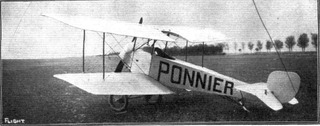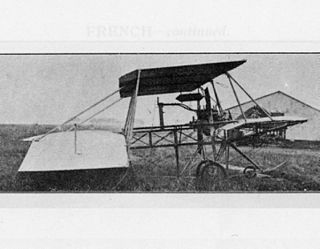Related Research Articles

The Avro 504 was a First World War biplane aircraft made by the Avro aircraft company and under licence by others. Production during the war totalled 8,970 and continued for almost 20 years, making it the most-produced aircraft of any kind that served in any military capacity during the First World War. More than 10,000 were built from 1913 until production ended in 1932.

The Sopwith Tabloid and Sopwith Schneider were British biplanes, originally designed as sports aircraft and later adapted for military use. They were among the first types to be built by the Sopwith Aviation Company. The "Tabloid", so named because of its small size, caused a sensation when it made its first public appearance.

The Roe IV Triplane was an early British aircraft designed by Alliott Verdon Roe and built by A.V. Roe and Company. It was first flown in September 1910.

The Avro Type D was an aircraft built in 1911 by the pioneer British aircraft designer A.V. Roe. Roe had previously built and flown several aircraft at Brooklands, most being tractor layout triplanes. The Type D was his first biplane.

The Avro Type E, Type 500, and Type 502 made up a family of early British military aircraft, regarded by Alliott Verdon Roe as his firm's first truly successful design. It was a forerunner of the Avro 504, one of the outstanding aircraft of the First World War.

The Avro 534 Baby was a British single-seat light sporting biplane built shortly after the First World War.

The Morane-Borel monoplane was an early French single-engine, single-seat aircraft. It was flown in several European air races.
The Pemberton-Billing P.B.25 was a First World War British single-seat scout aircraft built by Pemberton-Billing Limited, later Supermarine Aviation Works Limited.
The Sopwith Admiralty Type 807 was a 1910s British biplane seaplane designed and built for the Admiralty by the Sopwith Aviation Company.
The Sopwith Two-Seat Scout was a 1910s British biplane Anti-Zeppelin scout biplane designed and built for the Admiralty by the Sopwith Aviation Company. It was nicknamed the Spinning Jenny due to a tendency to enter a spin.

The Blackburn Triplane was a single-engine pusher single-seater, designed specifically to attack Zeppelins. It flew in 1917, but was not successful.

The de Havilland DH.27 Derby was a large single-engined biplane designed to a heavy day bomber Air Ministry specification. It did not reach production.
The Avro Burga was built by Avro for R.F. Burga to test his unique system of lateral control. It was a single-engined two-seat monoplane, fitted with differentially operated surfaces above and below the central fuselage.
The Avro 528 was an unsuccessful large span single-engined biplane built to an Admiralty contract in 1916. It carried a crew of two; only one was built.

The Vickers E.S.1 was an early British Fighter aircraft of the First World War. A single-seat biplane, only three E.S.1s were built, although at least one was used by a home defence squadron of the Royal Flying Corps.
The Royal Aircraft Factory S.E.4 was a single-engined, single seat biplane designed and built at the Royal Aircraft Factory just prior to the start of the First World War. Intended to be as fast as possible, it recorded a speed of 135 mph (217 km/h), which made it the fastest aircraft in the world in 1914, but no production followed and it was soon written off in a crash.

The RAE Scarab was a light single-engined single-seat parasol winged modification of the de Havilland Humming Bird, flying in the United Kingdom in 1932. Only one was built.

The Ponnier L.1 was an early French biplane single seat scout, built just before World War I. It did not reach production.

The Dunne-Huntington triplane, sometimes referred to as a biplane, was a pioneer aircraft designed by J. W. Dunne and built by A. K. Huntington. It was of unusual staggered triple-tandem configuration and an early example of an inherently stable aeroplane.
The Tokyo Koku Aiba-Tsubame or Tokyo Aviation Aiba-Swallow was a 1930s Japanese civil transport with seats for three passengers. It was intended to be cheap to produce so, although its fuselage was a new design, its wings and undercarriage were those of another Japanese aircraft. Two were built and flew taxi services and joyrides.
References
- ↑ Hugh Driver (1997). The Birth of Military Aviation: Britain, 1903-1914. Boydell & Brewer Ltd. p. 81. ISBN 978-0-86193-234-4.
- ↑ Jackson 1965 , pp. 71–2
- ↑ David Bremner (27 November 2018). Bristol Scout 1264: Rebuilding Granddad's Aircraft. Fonthill Media. p. 42. GGKEY:7DY7PAJ22FP.
- Jackson, A.J. (1965). Avro Aircraft since 1908. London: Putnam Publishing.CS1 maint: ref=harv (link)